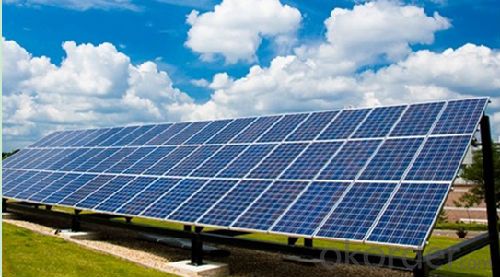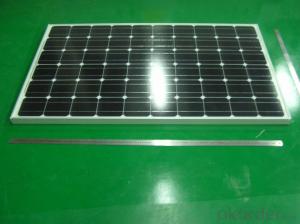Single Crystal Silicon Components 90W ASIA CNBM
- Loading Port:
- Shanghai
- Payment Terms:
- TT or LC
- Min Order Qty:
- 1 watt
- Supply Capability:
- 999999999 watt/month
OKorder Service Pledge
OKorder Financial Service
You Might Also Like
Description:
Currently more than 20 kinds of single crystal silicon components of blue sky solar production, power ranging from 50W to 315W, details please refer to annex "Si module parameter table".The products have obtained CE certification, CQC certification, TUV certification,Single crystal silicon components 90W。
BEST CONPONET
I. Solar Cell : High efficiency crystalline solar cell. Even if under the weak light, the solar module can produce maximum power output.
•II. Tempered glass (toughened glass): Anti-reflecting coating and high transmission rate glass increase the power output and mechanical strength of solar module.
•III . EVA and TPT: Using high quality EVA and TPT to prevent destroying and water
•IV . AI frame: Without screw, corner connection. 6 holes on the frame can be installed easily.
•V . Junction box: Multi function junction box with water proof.
Model Type | Good Quality 185W Solar Panel |
Peak Power-Pmax(W) | 185W |
Open Circuit Voltage-Voc(V) | 44.2 |
Maximum Power Voltage-Vmp(V) | 36 |
Short Circuit Current-Isc(A) | 5.4 |
Maximum Power Current-Imp(A) | 5 |
Maximum System Voltage | 1000V DC |
Maximum Series Fuse Rating | 10A |
Power Tolerance | -1~+3% |
Temperature Coefficients of Pmax | -0.45%/℃ |
Temperature Coefficients of Voc | -0.348%/℃ |
Temperature Coefficients of Isc | 0.031%/℃ |
Nominal Operating Cell Temperature | 44.5±2℃ |
Standard Testing Condition(STC) | Irradiance:1000W/m²;Temperature:25℃;AM=1.5 |
Qualification Test Parameters | |
Operating Temperature | -40℃~+85℃ |
Storage Temperature | -40℃~+85℃ |
Pressure Bearing | ≥5400Pascal/m² |
Wind Bearing | ≥5400Pascal/m² |
Mechanical Characteristics | |
Cell Size | Mono 125*125mm±0.5 |
No.of Cells | 72pcs(6*12) |
Dimension | 1580*808*40mm |
Weight | 15.5Kg |
Glass | 3.2mm High Transmission,Low Iron |
Frame | Anodized Aluminum Alloy |
Junction Box | IP65Rated |
Internal Diodes | 3 Bypass Diodes |
Cable | 1*4.0mm² Length 900mm |

FAQ:What's your products warranty?
Products Guarantee 12 yrs free from defects in materials and workmanship Performance Guarantee No less than 90% within 10yrs and no less than 80% within 25yrs
- Q:How much candle lights is required to operate a 205 watt solar panel?
- The intensity of direct sun is about 0,000 foot-candles. It would not be practical to light that many standard candles and put them foot away from the panel, but you could supply that intensity with electric lighting. That's in fact how they establish the power ratings of a given panel; they have a rig that provides a standard test condition of sun.
- Q:am having a 75 watts siemens solar panel and is giving me 2.89volts during bright light, i wanted to know can this be used to charge 00Am/hr battery?
- Many of the panels used on homes are designed to produce 2 volts DC. 0 of them wired in a series would produce 20 volts DC. An inverter is used to change the DC voltage to AC. The other aspect of electricity is amperage. With electrical units wired in series the voltage is added. When they are wired in parallel the amperage is added. The Volts x Amps produced will give you the wattage. A wise homeowner will examine their electric bills or the equipment used to determine their demand. They will consult tables that let them know how much sunlight their area receives each year as this will alter the rated performance of the panels. Then they will try and determine how much of the demand they want to fill. 80% may be economical. Then they also want to determine what they will do with excess electricity that may be produced during the summer months of intense sun and how they will supply the shortfall of low sun winter months. From all this they will determine the number of solar panels they need to purchase.
- Q:How do solar panels affect the overall carbon footprint of a building?
- Solar panels can significantly reduce the overall carbon footprint of a building. By harnessing clean and renewable energy from the sun, solar panels generate electricity without emitting greenhouse gases. This means that the building relies less on fossil fuel-based electricity, reducing its carbon emissions. Additionally, solar panels can offset the energy consumption of a building, further minimizing its carbon footprint, making it a sustainable and environmentally-friendly choice.
- Q:Can solar panels be installed on a landfill or waste management site?
- Yes, solar panels can be installed on a landfill or waste management site. In fact, these sites can provide suitable locations for solar panel installations due to their large open spaces and minimal shading. Additionally, repurposing landfill sites for solar energy generation helps to utilize otherwise unused land, reduces the environmental impact of waste management, and promotes the production of clean and renewable energy.
- Q:I am currently building a house, iv designed it to be as self sustainable as possible, I'm in the process of installing solar panels but as I'm ordering online I was hoping someone here could tell me how many I would need to completely run a 5 bedroom home, just standard household appliances such as fridge and freezers, plasma tvs computers and of course lighting, various things like that, also I'll need power storage as well, some type of large rechargeable battery, any help would be great.
- A typical home in America can use either electricity or gas to provide heat -- heat for the house, the hot water, the clothes dryer and the stove/oven. If you were to power a house with solar electricity, you would certainly use gas appliances because solar electricity is so expensive. This means that what you would be powering with solar electricity are things like the refrigerator, the lights, the compute?r, the TV, stereo equipment, motors in things like furnace fans and the washer, etc. Let's say that all of those things average out to 600 watts on average. Over the course of 24 hours, you need 600 watts * 24 hours = 4,400 watt-hours per day. From our calculations and assumptions abo?ve, we know that a solar panel can generate 70 milliwatts per square inch * 5 hours = 350 milliwatt hours per day. Therefore you need about 4,000 square inches of solar panel for the house. That's a solar panel that measures about 285 square feet (about 26 square meters). That would cost around $6,000 right now. Then, because the sun only shines part of the time, you would need to purchase a battery bank, an inverter, etc., and that often doubles the cost of the installation. If you want to have a small room air conditioner in your bedroom, double everything.
- Q:Are solar panels affected by temperature?
- Yes, solar panels can be affected by temperature. High temperatures can cause a decrease in their efficiency and overall power output. However, some modern solar panels are designed to handle higher temperatures more effectively, minimizing the impact on their performance.
- Q:What happens to solar panels during a power outage?
- During a power outage, solar panels do not generate electricity as they rely on the grid for their functioning. This is because most solar panel systems are grid-tied, meaning they are designed to feed excess power back into the grid and draw power from the grid when needed. However, some off-grid solar systems equipped with battery storage can continue to operate during a power outage, providing electricity to the connected devices or storing excess energy for later use.
- Q:I want to know that, is there any thing likehow much charge we can get per square feet. in a solar panel.let me know.also, I will appreciate if reference are given.
- I found some 0 square ft. solar panels that produce 30 watts . 3 watts per s.f. . A 2,000 s.f. home would consume around 2,000 kilowatt hours of electricity in summer months in areas that require air conditioning . This would require 67 kwh daily . You would need ,000 s.f. of panels and dozens of batteries to store the energy for night time .
- Q:What do I need to use this as a battery charger
- I hope this will help you choose your charge controller / battery charger more effectively. Good luck!
- Q:Thanks
- Initial cost , space occupied AND DAILY CYCLE (unless through a battery) are the only disadvantages. REST ARE ALL ADVANTAGES
1. Manufacturer Overview |
|
|---|---|
| Location | |
| Year Established | |
| Annual Output Value | |
| Main Markets | |
| Company Certifications | |
2. Manufacturer Certificates |
|
|---|---|
| a) Certification Name | |
| Range | |
| Reference | |
| Validity Period | |
3. Manufacturer Capability |
|
|---|---|
| a)Trade Capacity | |
| Nearest Port | |
| Export Percentage | |
| No.of Employees in Trade Department | |
| Language Spoken: | |
| b)Factory Information | |
| Factory Size: | |
| No. of Production Lines | |
| Contract Manufacturing | |
| Product Price Range | |
Send your message to us
Single Crystal Silicon Components 90W ASIA CNBM
- Loading Port:
- Shanghai
- Payment Terms:
- TT or LC
- Min Order Qty:
- 1 watt
- Supply Capability:
- 999999999 watt/month
OKorder Service Pledge
OKorder Financial Service
Similar products
New products
Hot products
Hot Searches
Related keywords




























